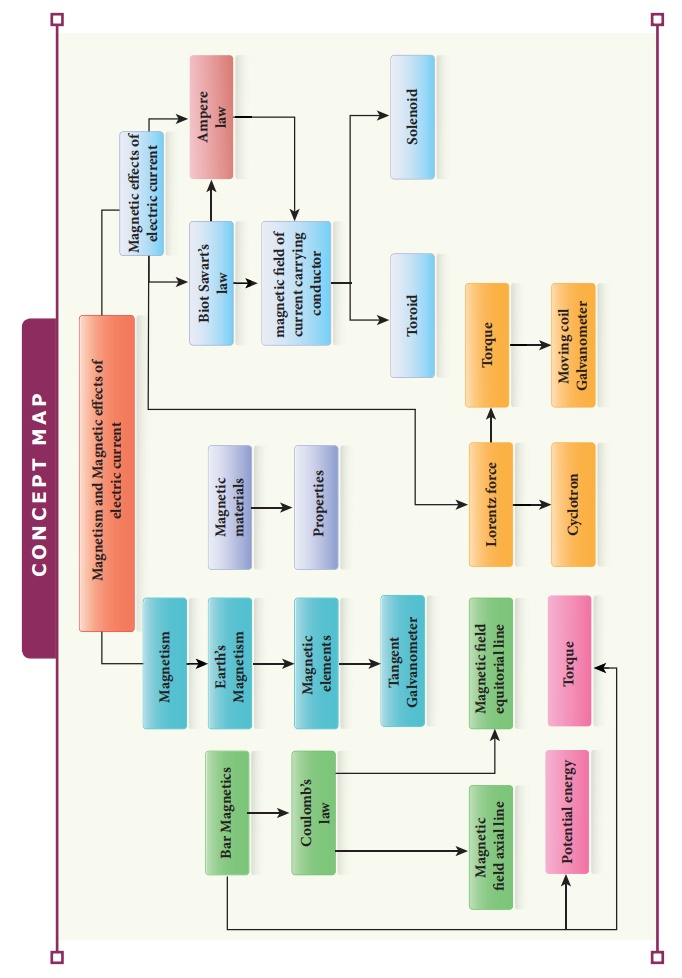Physics - Magnetism and Magnetic Effects of Electric Current: Summary | 12th Physics : Magnetism and Magnetic Effects of Electric Current
Chapter: 12th Physics : Magnetism and Magnetic Effects of Electric Current
Magnetism and Magnetic Effects of Electric Current: Summary
SUMMARY
·
A vertical plane passing through geographic axis is called
geographic meridian.
·
A vertical plane passing through magnetic axis is called magnetic
meridian.
·
The angle between magnetic meridian at a point with the
geographical meridian is called the declination or magnetic declination.
·
The angle subtended by the Earth’s total magnetic field B
with the horizontal direction in the magnetic meridian is called dip or
magnetic inclination at that point.
·
The magnetic moment is defined as the product of its pole strength
and magnetic length. It is a vector quantity, denoted by ![]() m
.
m
.
·
The region surrounding magnet where magnetic pole of strength
unity experiences a force is known as magnetic field. It is a vector quantity
and denoted by ![]() Its unit is N A-1 m1 .
Its unit is N A-1 m1 .
·
The number of magnetic field lines crossing per unit area is
called magnetic flux ΦB. It is a scalar quantity. In SI unit,
magnetic flux ΦB is Weber, symbol Wb.
·
Statement of Coulomb’s law in magnetism “The force of attraction
or repulsion between two magnetic poles is proportional to the product of their
pole strengths and inversely proportional to the square of distance between
them”.
·
Magnetic dipole kept in a uniform magnetic field experiences
torque.
·
Tangent galvanometer is a device used to measure very small
currents. It is a moving magnet type galvanometer. Its working is based on
tangent law.
·
Tangent law is B = BH tan θ.
·
The magnetic field which is used to magnetize a sample or specimen
is called the magnetising field. It is a vector quantity and denoted by ![]() and its unit is A m-1.
and its unit is A m-1.
·
The measure of ability of the material to allow the passage of
magnetic lines of force through it is known as magnetic permeability.
·
The net magnetic moment per unit volume of material is known as
intensity of magnetisation or magnetisation vector or magnetisation.
·
Magnetic susceptibility is defined as the ratio of the intensity
of magnetisation ( ![]() ) induced in the material due to the magnetising field (
) induced in the material due to the magnetising field ( ![]() ).
).
·
Magnetic materials are classified into three categories:
diamagnetic, paramagnetic and ferromagnetic materials.
·
The lagging of magnetic induction ![]() behind the
cyclic variation in magnetising field
behind the
cyclic variation in magnetising field ![]() is defined as
“Hysteresis”, which means “lagging behind”.
is defined as
“Hysteresis”, which means “lagging behind”.
·
The right hand thumb rule “If we hold the current carrying
conductor in our right hand such that the thumb points in the direction of
current flow, then the rest of the fingers encircling the wire points in the
direction of the magnetic field lines produced”.
·
Maxwell right hand cork screw rule “If we rotate a screw by a
screw driver, then the direction of current is same as the direction in which
screw advances, and the direction of rotation of the screw will determine the
direction of the magnetic field”.
·
Ampère’s circuital law is 
·
Magnetic field inside the solenoid is B = µ nI, where n is
the number of turns per unit length.
·
Magnetic field interior to the toroid is B = µ nI,
where n is the number of turns per unit length.
·
Lorentz force is 
·
Charged particle moving in a uniform magnetic field will undergo
circular motion.
·
Fleming’s Left Hand Rule: Stretch forefinger, the middle finger
and the thumb of the left hand such that they are in mutually perpendicular
directions. If we keep the forefinger in the direction of magnetic field, the
middle finger in the direction of the electric current, then the thumb points
in the direction the force experienced by the conductors.
·
One ampere is defined as that current when it is passed through
each of the two infinitely long parallel straight conductors kept at a distance
of one meter apart in vacuum causes each conductor to experience a force of 2 Ă—
10-7 newton per meter length of the conductor.
·
When a current carrying coil is placed in a uniform magnetic
field, the net force on it is always zero but net torque is not zero. The
magnitude of net torque is τ = NABI sin θ.
·
Moving coil galvanometer is an instrument used for the detection
and measurement of small currents.
·
In moving coil galvanometer, current passing through the
galvanometer is directly proportional to the deflection. Mathematically, I =
Gθ, where G= Κ/ΝΑΒ is called galvanometer constant or current reduction factor of the
galvanometer.
·
Current sensitivity is defined as the deflection produced per unit
current flowing through it, 
·
Voltage sensitivity is defined as the deflection produced per unit
voltage which is applied applied across it, Vs =θ/V = 1/GRs = Is/Rs, where, Rg
is the resistance of galvanometer.
·
Ammeter is an instrument used to measure current in an electrical
circuit.
·
A galvanometer can be converted into an ammeter of given range by
connecting a suitable low resistance S called shunt in parallel to the given
galvanometer.
·
An ideal ammeter has zero resistance.
·
Voltmeter is an instrument used to measure potential difference
across any element in an electrical circuit.
·
A galvanometer can be converted into suitable voltmeter of given
range by connecting a suitable resistance R in series with the given
galvanometer.
·
An ideal voltmeter has infinite resistance.

Related Topics